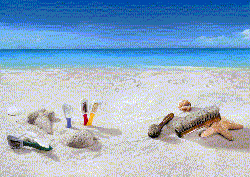Transfer service policy
The most important instruments of transfer service policy are location policy, the design of points of sale, goods placement and presentation and sales personnel policy.*Location Strategies
Location is widely considered to be the most important marketing policy instrument in the retail sector; it will however not be dealt with here because of its complexity as a topic.Design of the Points of Sale
 In General:
In General:Each retail outlet is – from a behavioural psychology point of view – initially unknown territory. Our mind and body prepare themselves unconsciously for danger and conflict; a well-designed light concept takes away the cave-like characteristics of the retail outlet: brighter lights in the entrance area and in the rear sales areas make all areas of the sales floor visible from outside and lessen our insecurity in the shop itself. Insecurity means stress and makes people restless and uneasy. Our aim, however, is to make the customer comfortable and willing to spend time at the retail outlet. This comfortable feeling can be supported by the use of music, pictures, potted plants… everything that gives rise to positive emotions such as holiday feelings, being stress-free…**
This is probably the reason why we buy the most while we are on holiday…
The smallest details:
Even the smallest details in the goods displays and other decorative furnishing elements lead to a total impression for the customer that increases their willingness to buy. The findings of colour psychologists are of particular meaning and are not yet given sufficient consideration in practice *: red, for example, in the ideal colour for fast perception. It gives rise to an unconscious orientation reaction, a reflex-like observation without having an aggressive effect.** If you want to know more about the effect of colours, take a look at our Newsletter 10/03.
Goods placement and presentation
 Shelf optimisation and space management are concepts that allow purposeful distribution of articles on the shelf or other goods displays. This concept can be used to achieve special customer guidance and an increase of the time spent in the retail outlet with the result of higher sales turnover and an increase in customer satisfaction. Newest developments tend towards taking account of both quantitative parameters and qualitative influences based on environmental psychology when optimising goods placement*:
Shelf optimisation and space management are concepts that allow purposeful distribution of articles on the shelf or other goods displays. This concept can be used to achieve special customer guidance and an increase of the time spent in the retail outlet with the result of higher sales turnover and an increase in customer satisfaction. Newest developments tend towards taking account of both quantitative parameters and qualitative influences based on environmental psychology when optimising goods placement*:70% of people in our culture move spontaneously to the right when they enter a sales area and then continue to move, for whatever reasons, in anti-clockwise circles within the space. When we stand in front of a shelf we focus first on the right-hand side and prefer to pick up an object with our right hand. As a consequence of this the goods to which the customer’s attention should be directed are best place to the right of the shelf or display. The customer is four to eight times as likely to reach for products placed at grasping or eye level then those in less convenient places above or below this.
The particulars of how many centimetres in the shelf or display are allocated to each article, influences purchasing behaviour in direct proportion. The length of the contact distance is a decisive influence on whether indecisive customers are successfully convinced to make a purchase.
Another ideal place to convince customers to make a purchase is at the cash register. The customer has already selected the goods that he needs by the time he is standing at the cash register, the shopping stress has disappeared, and he is calmer and more receptive to purchase stimuli. The customer’s attention moves to the goods in grasping or eye-level placed before him and he may select a product. If the customer is called for payment at the just the moment when he is holding the brush or the shoe spray then he is put in a stress situation from which he can most easily escape by putting his hand back to the goods he has already selected and is then able to look for a wallet or purse.**
You should, therefore, try to place your displays to the right of the cash register counter and to place the products in such a way that the most important (e.g.: the brushes) are at grasping or eye level.
Sales personnel policy
 The appearance, conduct and functional ability of the sales personnel must be in accordance with the requirements of the type of operation. For service-oriented operations the qualification of the sales personnel is of great importance.*
The appearance, conduct and functional ability of the sales personnel must be in accordance with the requirements of the type of operation. For service-oriented operations the qualification of the sales personnel is of great importance.*A sale is an interpersonal process in which the salesperson provides information on a product, convinces the customer of its quality and gives advice on use and selection whilst leading the customer to make a purchase. In order to be able to fulfil these requirements properly the salesperson needs comprehensive knowledge of the product and must be able to use the various sales techniques.***
Training of sales personnel is therefore an important marketing instrument.
*According to: Ulrich D. Frey (2001): POS-Marketing. Integrierte Kommunikation für den Point of Sale. Betriebswirtschaftlicher Verlag Dr. Th. Gabler GmbH, Wiesbaden.
**According to: Udo Pollmer et al. (1997): Liebe geht durch die Nase. Was unser Verhalten beeinflusst und lenkt. Verlag Kiepenheuer & Witsch, Köln.
***According to: Hans Christian Weis (1987): Marketing. Kompendium der praktischen Betriebswirtschaft. Friedrich Kiehl Verlag GmbH, Ludwigshafen (Rhein).



